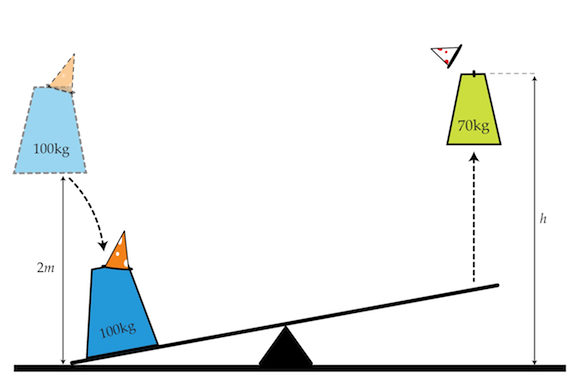Jumping clowns
A clown of mass
1
0
0
kg
jumps from a height of
2
m
onto one end of a seesaw, which is above the ground (see figure). On the other end of the seesaw, which is on the ground, is a
7
0
kg
clown who is launched into the air vertically upwards. If
2
/
3
of the total energy of the first clown is transferred to the second, how high in the air does the second clown go
in meters
?

Details and assumptions
- You may neglect air resistance.
The answer is 1.9.
This section requires Javascript.
You are seeing this because something didn't load right. We suggest you, (a) try
refreshing the page, (b) enabling javascript if it is disabled on your browser and,
finally, (c)
loading the
non-javascript version of this page
. We're sorry about the hassle.
6 solutions
so long :p
The first clown used ( 1 0 0 k g ) ( 2 m ) = 2 0 0 J of energy. 3 2 of that is transferred, which is 3 4 0 0 J . Since the mass of the other clown is 7 0 k g , he moved up 7 0 k g 3 4 0 0 J = 1 . 9 0 m .
So... mass*distance = energy????
I guess theres no formula llike such
The 1st clown has a mass of 100 kg and height from the ground is 2 m.
P E i = m g h
P E i = ( 1 0 0 ) ( 9 . 8 ) ( 2 )
P E i = 1 9 6 0 J
The 2nd clown has a mass of 70 kg and the height is unknown.
P E f = 3 2 P E i
Thus,
P E f = 1 3 0 6 . 6 7 J
P E f = m g h
h = m g P E f
h = ( 7 0 ) ( 9 . 8 ) 1 3 0 6 . 6 7
h = 1 . 9 m
Energy of 7oKg clown = 2/3 of energy of 100 kg clown 70xgxh= 2/3x2xgx2 on solving for h, h = 1.904m
Another solution: 100×2÷(70h)=3/2 thus h=40/21
mgh=mgh 100 g 2=70 g h h=20/7
Since 2/3 energy is transferred,
2/3*20/7 =1.9
Total potential energy of first clown at the beginning was 1 0 0 × 2 × g = 2 0 0 g . 3 2 of the energy was lost, so we are left with 3 4 0 0 g joules of energy for the second clown. Now, this energy equals the potential of the second clown at the highest point which is 7 0 h g . Equating the two, canceling the g s and solving for h gives us our answer 1 . 9
The gravitational energy of the first clown can be calculated by
G P E = 1 0 0 ⋅ g ⋅ 2 = 2 0 0 ⋅ g
Since 3 2 of the first clown's energy is transferred to the second clown, then the second clown will have 3 2 ⋅ 2 0 0 ⋅ g = 3 4 0 0 ⋅ g gravitaitonal potential energy. To find the height of the second clown, we do:
3 4 0 0 ⋅ g = 7 0 ⋅ g ⋅ h
Rearranging for h, we find that:
h = 2 1 4 0 0 ≈ 1 . 9
Should say 210 on the final line.
Step 1: v 2 = u 2 + 2 a s = 0 2 + 2 × 9 . 8 m/s 2 × 2 m = 3 9 . 2 m 2 / s 2
Step 2:
E k = 2 1 m v 2 = 2 1 × 1 0 0 kg × 3 9 . 2 m 2 / s 2 = 1 9 6 0 J
Step 3:
E k × 3 2 = 1 9 6 0 J × 3 2 = 3 3 9 2 0 J
Step 4:
E k = 2 1 m v 2 = 2 1 × 7 0 kg × v 2 = v 2 × 3 5 kg = 3 3 9 2 0 J
∴ v 2 = 3 × 3 5 3 9 2 0 m 2 / s 2 = 3 1 1 2 m 2 / s 2
Step 5:
v 2 = u 2 + 2 a s = 0 2 + 2 × 9 . 8 m/s 2 × s = s × 1 9 . 6 m/s 2
∴ s = 1 9 . 6 m/s 2 v 2 = 1 9 . 6 m/s 2 3 1 1 2 m 2 / s 2 = ( 3 × 1 9 . 6 1 1 2 ) m ≈ 1 . 9 m
Therefore, the required answer is 1 . 9 !
Note:
Sorry for being shortcut...
That was a nice trick, showing h larger than the left side's height in the picture... I was a bit confused about the answer at first!!!